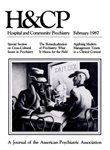Cross-Cukural Aspects of the Somatization Trait
Abstract
Studies using a variety of diagnostic rating scales have identified much higher levels of somatic symptoms in Hispanic psychiatric patients, particularly those with a diagnosis of schizophrenia or depression, than in their An- glo counterparts. However, this cultural difference cannot be generally demonstrated by using DSM-IlI somatoform disorders criteria. Many patients with "unfounded" somatic symptoms have another DSM-III primary diagnosis that is often assumed to cause or explain the somatic symptoms. In addition, the true prevalence of unfounded somatic symptoms is hidden because of the strict criteria required for a DSM-III primary diagnosis of somatization disorder. The author believes a more inclusive notion of somatization should be developed that would substantiate the presence of this trait among different populations and, if operationalized, would facilitate research on this important phenomenon. This is relevant not only because of the cross-cultural variability of somatization traits but also because they may become a salient feature of the primary syndrome and determine the use of dinical services. He proposes a new operational definition of somatization that encompasses the trait concept.
Access content
To read the fulltext, please use one of the options below to sign in or purchase access.- Personal login
- Institutional Login
- Sign in via OpenAthens
- Register for access
-
Please login/register if you wish to pair your device and check access availability.
Not a subscriber?
PsychiatryOnline subscription options offer access to the DSM-5 library, books, journals, CME, and patient resources. This all-in-one virtual library provides psychiatrists and mental health professionals with key resources for diagnosis, treatment, research, and professional development.
Need more help? PsychiatryOnline Customer Service may be reached by emailing [email protected] or by calling 800-368-5777 (in the U.S.) or 703-907-7322 (outside the U.S.).



